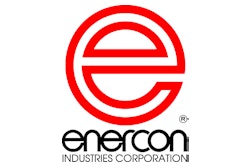
Engineers at Nestlé New Zealand’s Cambria Park facility installed a new Pack Line auger filling system for powder products in December 2001. But it wasn’t until April of 2003, when they added an induction-sealing station to the heat-sealing operation already in place, that management was satisfied with seal integrity on its non-round PET containers. The new multi-layer induction-seal membrane, supplied by Unipac, consists of polyester, aluminum foil, polyolefin foam, polyester. Applied by an induction sealing unit from Enercon, the membrane features the patented Lift ‘n’ Peel™ easy-opening design.
According to Greg Smith, project engineer at the Nestlé facility, a key advantage gained by switching to induction sealing revolves around placement. The heat-sealed membrane used formerly had to be picked from a magazine and placed precisely over the plastic containers and tacked on to hold it in place before heat sealing. The containers were then conveyed, two-by-two, beneath a sealing tool that descended and sealed the membrane to the container. Imperfect placement of the sealing membrane used to cause a faulty seal, resulting in reduced shelf life and product damage.
This difficulty with placement is not an issue with an induction-sealed membrane because the membrane isn’t being applied separately from the cap. Rather, it’s captured inside the plastic snap-on closure as the closure is applied. When the container passes through the induction sealing head a short distance downstream from the capper, a high-intensity alternating magnetic field causes the foil in the membrane to heat up, which in turn causes the heat-seal coating on the container side of the foil membrane to bond to the land of the container neck finish. This creates a water-tight, hermetic seal that greatly improves the product’s shelf life.
Smith says this is inherently less challenging than applying the heat-sealed membrane, which involved both tack sealing in one station and final sealing in another. Captured as it is inside the closure, there’s nowhere for the induction seal membrane to go but where it’s supposed to.
“Simply put, the induction sealing system produces a far superior seal,” Smith says.
Also worth noting is that the cap, supplied by Amcor Packaging, is not round. This represented a special challenge to the engineers at Enercon because the induction currents fundamental to induction sealing typically run in a circular or oval pattern. Through proprietary design technology, Enercon’s engineers came up with a way to force the currents in a non-circular pattern.
The logistics
To add induction-sealing to its filling line, Nestlé had to find an induction-sealing system fast enough to keep pace with the two-up auger filler, an intermittent-motion machine that cycles 21 times/min. That meant induction sealing would have to take place in 0.7 sec. Enercon, says Smith, was up to the task.
“Enercon Industries managed to achieve this short seal time by shaping the induction heads to fit within the container lids,” Smith says. “This helped draw the heating effect towards the outer corners of the container to produce an even seal throughout the container rim.”
Filling on the Cambria Park line begins with denesting of containers into side-by-side “cassettes” that move horizontally along the machine bed. They are filled by two augers. From there, they are moved to a capping station.
While most induction-sealing applications involve a round container and a threaded cap that is torqued down, the cap on Nestlé’s non-round PET container is snapped on. Without a torqued-on threaded closure to press the induction seal membrane firmly against the land of the container finish, proper induction sealing cannot occur. So Nestlé added a special indexing unit whose pneumatic lifts elevate the containers and press them against the induction sealing heads. This supplies the additional pressure required for induction sealing. These heads also are fitted with a pad that results in more reliable sealing because it molds itself to slight imperfections in the cap.
Because this particular line is used to package several other Nestlé products equipped with heat-sealed membranes, engineers chose to leave the heat-sealing station in place. For containers that require induction sealing, however, the heat-sealing unit is simply bypassed.
Finished packages exit the induction sealing station prior to being checkweighed, labeled, and packed into shipping containers.

























